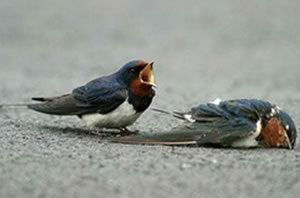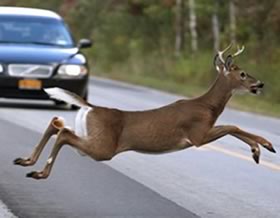FAQs
Found a bird in need?
With experience from hundreds of birds each year, we can help you determine if the situation calls for rescue or further observation.

Every year more and more birds are found along our roads, under power lines, and in our own backyards. It can be very difficult at times to determine if a bird actually needs to be brought in to a rehabilitation facility. Please remember we are here to help you and the birds!
Baby or Fledgling Birds
Contrary to popular myth, touching a baby bird will not cause its parents to reject it. If you find an uninjured baby bird that has no feathers, only soft down or quills, it has probably fallen from its nest. Return the bird to its nest if possible. If you can’t reach the nest, you can make a replacement nest to put in the tallest branch you can reach. The replacement nest can be a small box or a berry basket and it can be attached to the branch with rope or string. Leave the area and watch for the mom bird from a distance. If you don’t see the mom bird coming to the baby in 3-4 hours, you will need to take it to a wildlife center. Injured baby birds should be taken to a wildlife center as soon as possible.
Fledgling birds generally spend a few days on the ground while learning to fly. If the bird has feathers and a short tail, is uninjured, and can stand and hop, it is a fledgling bird and the parents should continue to feed them throughout stage. If there is no danger in the area, they should be left alone. If you think it is orphaned, watch the bird from a distance and see if the parents come and feed it throughout the day. If cats and dogs are a threat, place the bird in nearby bushes or on a tree limb. Try to keep your pets inside. If the fledgling still appears to be in danger or is injured, call a wildlife center.
Adult Birds
A bird that has hit a window should be placed in a warm box and put in a quiet place for 3-4 hours. If the bird has not recovered by then, call a wildlife center. To prevent birds from flying into a window, close drapes, hang blinds or place decals on your window. A bird that has been attacked by a cat or dog should be taken to a wildlife center for treatment. Place two large bells on your outdoor cat’s collar to help warn off birds.
If you find an injured adult raptor, call a wildlife center before trying to handle the animal. If you must handle the raptor, always wear thick, heavy leather gloves and hold tightly to the legs. Cover their heads with a sheet or towel when handling.
Questions we will ask when you call us 509.952.9334.
- Where is the bird? (e.g. park, road, backyard)
- Why do you think the bird needs help?
- Have you tried approaching the bird?
- How close to the bird did you get?
- Has the bird moved from it’s original position?
- We will ask you to describe the bird in detail. Identifying the species can help determine normal and abnormal behavior.
- Are the eyes bright and alert when you approach?
- Are both wings being held evenly (either next to the body or spread out to threaten)?
- Are there any obvious signs of injury?
Found an animal in need?
 What to do if you feel you have found an injured or abandoned animal .
What to do if you feel you have found an injured or abandoned animal .
Many State and Federal laws prohibit the keeping of wildlife unless you are licensed to do so. Wildlife Rehabilitators are trained to care for many types of wildlife, know the natural history of wildlife, work with veterinarians and have received the proper permits. They can provide the most appropriate foods, socialization and medical care to help return the animal back to the wild. Many internet tips on what to feed wildlife are incorrect and can lead to the animal’s death.
Keep in mind that not all wildlife needs our help. Baby birds with feathers spend some time on the ground as they learn to fly and their parents are usually nearby. Fawns are left alone for several hours while their mothers go off to feed.
Wildlife becomes highly stressed from human contact and capture. To minimize stress:
- Always keep yourself safe first.
- If you can safely capture the animal, put it in a warm, quiet, undisturbed place.
- Avoid handling it as much as possible.
- Do not give it food or water.
- Call us at 360.966.8845 so we can assess the situation.
*Note: Please wait for a staff person or volunteer to return your call before bringing the animal to the wildlife center.
Bats
If you find a bat on the ground do not touch it! Bats in Washington can carry rabies and it is transmitted through the animals’ saliva. Call a wildlife center or the health department before rescuing a bat. If you must move it, wear heavy, thick leather gloves and cover all exposed skin. If you are bitten, save the animal for examination, wash the wound immediately with soap and water and call your doctor right away.
If a bat is roosting on a wall or tree, it is most likely fine. Leave it alone. If it falls from its roost, it may need 20 minutes or so to wake up and fly off. Leave it alone.
Deer
Fawns ~ Mother deer leave their fawns alone for large portions of the day. The fawn will settle down and wait for her, curled up in a “don’t notice me” position. This is normal and do not disturb a fawn who is laying down.
If the fawn looks cold, hungry, confused, or sick, call a wildlife center or park ranger. Do not feed the animal. If you must transport the animal, place it in a dog carrier lined with a towel or sheet and cover the carrier with a sheet or towel. Keep it quiet and warm.
Adults ~ Adult deer are very dangerous and have the potential to hurt or kill you if you try to help them. If the animal is injured please call a wildlife center or the state patrol. Deer are very high stress animals and can actually die from the stress. Keep away from injured adult deer.
Opossums
Adult opossums are not typically aggressive. If injured, they can be placed into a pet carrier or box by grabbing the base of the tail while wearing thick leather gloves. Avoid the head and mouth. You can also use a shovel to gently lift them into a box. If the opossum is dead, check the pouch (which is on the abdomen) for babies. If there are babies attached to the nipples in the pouch, bring the dead mom to a wildlife center. Do not try to remove the attached babies. If the babies are not attached, put them into a warm box and take them to a wildlife center.
If you find an opossum that you think is orphaned, call a wildlife center first. If the opossum is 7 inches from nose to rump, it is old enough to be on its own. Do not rescue it unless it is injured.
Rabbits
Baby Rabbits ~ If you find healthy bunnies that are 4-5 inches long, able to hop, with eyes open and ears up, they do not need help. They are old enough to survive on their own. If you find a smaller healthy bunny, put it back in the nest and leave it undisturbed for several hours. If the nest has been damaged, put it back together and place a light layer of grass over the baby. Leave the area. The mom will only return at dawn and dusk. If the baby is obviously injured or orphaned, call a wildlife center. Put the animal in a warm box with a towel and keep it in a quiet area. Do not feed the bunny and do not handle the bunny! They can die easily from stress. Take to the wildlife center as soon as possible.
Adults ~ If injured, place the rabbit in an escape proof box or carrier. Wear gloves and cover the animal with a sheet or towel and support the back feet when picking it up. Rabbits can kick very hard and may break their own back by doing so. Cover the box or carrier with a sheet or towel to make it dark. Put in a warm, dark, quiet area until you can get it to a wildlife center.
Raccoons
Raccoons are very aggressive animals and should not be handled by the public, unless the animal is so injured that it cannot move. Even young raccoons can be very aggressive. Call a wildlife center before touching or rescuing a raccoon.
Skunks
Skunks are also very aggressive animals and should not be handled by the public, unless the animal is so injured that it cannot move. Skunks are very accurate at spraying and will aim for your eyes, so always wear safety goggles when approaching a skunk. Even baby skunks can spray if they are scared, so call a wildlife center before rescuing a skunk.
Squirrels
Baby Squirrels- If the baby appears uninjured and is warm to the touch, place it in a shallow, towel-lined box a the base of the tree and leave it undisturbed for 4-6 hours. Often, the mother will come down and carry the baby off. She will not come down if people or pets are nearby, so stay clear. If the baby is cold, put a hot water bottle under the towel it is resting on and put at the base of the tree. If the mother does not reclaim the baby within 4 hours or by dark, bring the baby inside and keep it warm until it can be taken to a wildlife center. Injured baby squirrels should be taken to a wildlife center as soon as possible.
Adults- Adult squirrels can be very aggressive and they have very sharp teeth and claws. If it is injured, place the animal into a escape proof box or carrier wearing heavy leather gloves. Cover the carrier or box with a sheet or towel and call a wildlife center.

